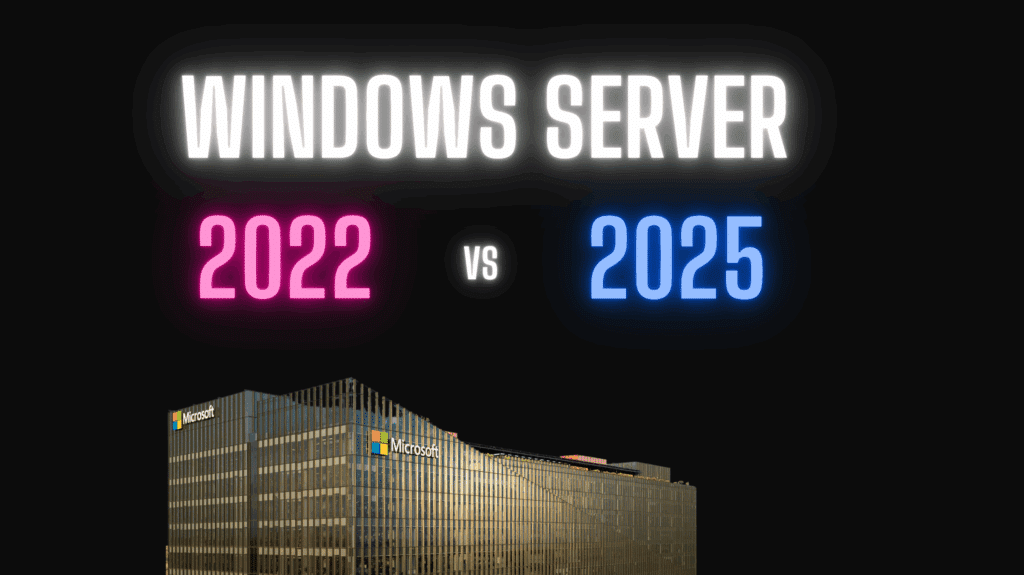Windows Server 2022 vs 2025: Features, Licensing, and Pricing Comparison

Windows Server 2022 vs 2025: A Comprehensive Comparison of Features, Licensing, and Pricing
Microsoft’s Windows Server 2025 introduces significant enhancements over Windows Server 2022, with modernized features, enhanced security, and updated pricing structures. This comparison examines the key differences to help organizations make informed infrastructure decisions.
New Features in Windows Server 2025
Windows Server 2025 adopts the Windows 11 design language, providing a contemporary interface with native Bluetooth support for wireless peripherals [1]. Key additions include DTrace for real-time system monitoring, enhanced file compression supporting ZIP, 7z, and TAR formats, and improved cloud identity integration with Microsoft Entra ID [1].
The platform introduces a modernized Task Manager with Mica design, customizable Start menu with administrative tools, and default Wireless LAN Service installation. Security enhancements include Credential Guard enabled by default and Active Directory improvements with optional 32k database page sizes [1].
Removed and Deprecated Features
Windows Server 2025 removes several legacy components to improve security and reduce maintenance overhead [5]. Completely removed features include Data Encryption Standard (DES), IIS 6 Management Console, NTLMv1 authentication, SMTP Server, and WordPad.
Deprecated features scheduled for future removal include Computer Browser service, Network Load Balancing (NLB), Remote Mailslots, TLS 1.0/1.1, Windows Internal Database (WID), WMIC, and PowerShell 2.0 Engine [5]. Organizations must plan migration strategies for applications dependent on these features.
Feature Comparison Tables
New Features Exclusive to Windows Server 2025
| Feature Category | Feature | Description | Business Impact |
|---|---|---|---|
| User Interface | Windows 11 Style Desktop | Modern interface with contemporary design elements | Improved administrator productivity and familiarity |
| Connectivity | Native Bluetooth Support | Direct wireless peripheral connectivity | Simplified hardware setup and reduced dependencies |
| File Management | Enhanced Compression | ZIP, 7z, TAR support with right-click interface | Streamlined file archival and storage optimization |
| System Monitoring | Native DTrace | Real-time system instrumentation and analysis | Advanced troubleshooting and performance optimization |
| Authentication | Cloud Identity Integration | Microsoft Entra ID and modern account support | Enhanced hybrid identity management capabilities |
| User Experience | Customizable Start Menu | Pinned applications for administrative tools | Optimized administrative workflow and efficiency |
| System Management | Modern Task Manager | Mica design with enhanced monitoring capabilities | Improved system administration and diagnostics |
| Network Services | Default Wireless LAN Service | Simplified wireless connectivity enablement | Flexible deployment options and connectivity |
Removed Features Comparison
| Feature | Windows Server 2022 Status | Windows Server 2025 Status | Recommended Alternative |
|---|---|---|---|
| Data Encryption Standard (DES) | Disabled by default | Completely removed | AES encryption algorithms |
| IIS 6 Management Console | Deprecated | Completely removed | Current IIS management tools |
| NTLMv1 Authentication | Deprecated | Completely removed | Negotiate protocol with Kerberos |
| SMTP Server | Available | Completely removed | Exchange Server or third-party SMTP |
| WordPad | Available | Completely removed | Microsoft Word or Notepad |
| Computer Browser | Deprecated | Deprecated | Modern network discovery methods |
| Network Load Balancing | Available | Deprecated | Software Load Balancer (SLB) |
| Remote Mailslots | Deprecated | Deprecated | Modern IPC mechanisms |
| TLS 1.0/1.1 | Available | Disabled by default | TLS 1.2 or higher |
| WMIC | Available | Feature on Demand only | PowerShell for WMI |
| PowerShell 2.0 Engine | Available | Not installed by default | PowerShell 5.1 or 7.x |
Security Enhancement Comparison
| Security Feature | Windows Server 2022 | Windows Server 2025 | Enhancement Details |
|---|---|---|---|
| Credential Guard | Available with configuration | Enabled by default | Automatic protection on compatible systems |
| Hotpatch | Preview in Azure Edition | Preview for Azure Arc | Expanded availability for hybrid scenarios |
| Active Directory | Standard capabilities | 32k database page size | Enhanced scalability for large deployments |
| Encryption Standards | DES disabled by default | DES completely removed | Elimination of weak encryption methods |
| Authentication | NTLM available | NTLMv1 removed, NTLMv2 deprecated | Stronger authentication requirements |
| Network Security | TLS 1.0/1.1 available | TLS 1.0/1.1 disabled by default | Enhanced transport security |
Detailed Pricing Analysis
Windows Server 2025 introduces significant pricing changes that impact total cost of ownership calculations. The Standard Edition shows reduced pricing while Datacenter Edition costs increase substantially.
Base Server License Costs
| Edition | Windows Server 2022 | Windows Server 2025 | Price Difference | Percentage Change |
|---|---|---|---|---|
| Standard (16 cores) | $1,680 (with 10 CALs) | $1,176 (license only) | -$504 | -30% (license portion) |
| Standard (license only) | ~$1,280 (estimated) | $1,176 | -$104 | -8.1% |
| Datacenter (16 cores) | ~$3,500 (estimated) | $6,771 | +$3,271 | +93.5% |
Client Access License Costs
| CAL Type | Quantity | Windows Server 2022 | Windows Server 2025 | Price Difference |
|---|---|---|---|---|
| User CAL | 1 License | ~$40-45 (estimated) | $39.99 | Minimal change |
| User CAL | 5 License Pack | ~$200-225 (estimated) | $189.95 | -$10-35 |
| Device CAL | 1 License | ~$40-45 (estimated) | $38.99 | Minimal change |
| Device CAL | 5 License Pack | ~$200-225 (estimated) | $189.95 | -$10-35 |
Total Cost of Ownership Scenarios
| Scenario | Server Config | Windows Server 2022 | Windows Server 2025 | Cost Difference |
|---|---|---|---|---|
| Small Business | 1 server, 16 cores, 25 users | $2,680 ($1,680 + $600 CALs) | $2,176 ($1,176 + $1,000 CALs) | -$504 |
| Medium Enterprise | 2 servers, 32 cores, 100 users | $7,760 ($3,360 + $4,400 CALs) | $6,352 ($2,352 + $4,000 CALs) | -$1,408 |
| Large Datacenter | 4 servers, 64 cores, unlimited VMs | $14,000 (estimated) | $27,084 ($27,084 + CALs) | +$13,084 |
Virtualization Licensing Comparison
Standard Edition Virtualization Rights
| Feature | Windows Server 2022 | Windows Server 2025 | Notes |
|---|---|---|---|
| Physical Server Rights | 1 instance per license | 1 instance per license | Unchanged |
| Virtual Machine Rights | 2 VMs per license | 2 VMs per license | Unchanged |
| Hyper-V Containers | 2 containers per license | 2 containers per license | Unchanged |
| Storage Replica | 1 partnership, 2TB volume | 1 partnership, 2TB volume | Unchanged |
Datacenter Edition Virtualization Rights
| Feature | Windows Server 2022 | Windows Server 2025 | Notes |
|---|---|---|---|
| Physical Server Rights | 1 instance per license | 1 instance per license | Unchanged |
| Virtual Machine Rights | Unlimited VMs | Unlimited VMs | Unchanged |
| Hyper-V Containers | Unlimited containers | Unlimited containers | Unchanged |
| Storage Replica | Unlimited partnerships | Unlimited partnerships | Unchanged |
Strategic Recommendations
Windows Server 2025 Standard Edition offers improved value with reduced pricing and enhanced features, making it attractive for organizations with limited virtualization needs. However, the substantial Datacenter Edition price increase requires careful justification through extensive virtual machine deployments.
Organizations should evaluate security requirements, as Windows Server 2025’s enhanced security features, removal of weak encryption standards, and improved compliance capabilities provide significant value for regulated industries. The removal of legacy features requires compatibility assessments and migration planning for affected applications.
For hybrid cloud strategies, Windows Server 2025’s enhanced Azure Arc integration ($33.58 per CPU core monthly) and modern management capabilities support long-term architectural objectives [4]. Organizations should align licensing decisions with actual infrastructure requirements, virtualization strategies, and growth projections.
Windows Server 2025 supports in-place upgrades from Windows Server 2012 R2 and later versions, providing flexible migration options [1]. The consistent licensing model between versions facilitates budget planning and reduces complexity during transitions.
Windows Server 2025 represents a significant platform evolution with enhanced security, modern management capabilities, and updated pricing structures. While Standard Edition pricing improvements benefit smaller deployments, Datacenter Edition costs require careful evaluation. Organizations should conduct comprehensive assessments considering direct costs, operational impacts, security requirements, and strategic objectives when choosing between Windows Server 2022 and 2025.
References
[1] Microsoft Learn. (2025, February 28). What’s new in Windows Server 2025
[2] Microsoft Learn. (2025, April 8). What’s new in Windows Server 2022
[3] Microsoft Store. (2025). Buy Windows Server 2022 Standard Edition
[4] Microsoft. (2025). Windows Server 2025 Licensing & Pricing
[5] Microsoft Learn. (2025, April 28). Features removed or no longer developed in Windows Server
[6] Trusted Tech Team. (2025). Microsoft Windows Server 2025 Client Access Licenses










